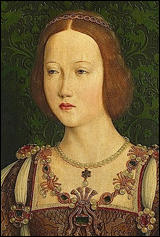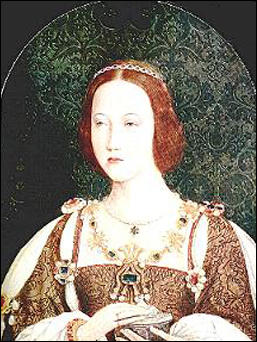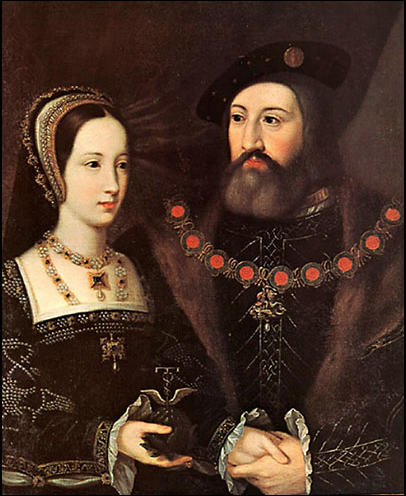Mary, Duchess of Suffolk

Mary, the third daughter and fifth child of Henry VII was born in about March 1496. Henry, who had become king in 1485, was determined that the Tudor family should rule England and Wales for a long time. To do this he needed to protect himself from those who had the power to overthrow him. His first step was to marry Elizabeth of York, the eldest child of Edward IV. (1)
David Loades has pointed out: "Little is known of her upbringing beyond what can be learned from the household accounts. She had her own physician, apothecary, and schoolmaster, as well as attendant ladies. Frequent references to medication suggest delicate health, but they may prove no more than conscientious accountancy. It can be deduced that her schoolmaster taught her Latin and French - although probably not to the same rigorous standards as her brother (Henry) because later in life she is known to have had some intellectual interests." (2)
Young princesses were "pawns on the chessboard of royal politics" and negotiations to find her a husband began when she was only two years old. The first offer of the son of Ludovico Sforza, the Duke of Milan, was rejected. On 27th December 1507, Emperor Maximilian I reached agreement for Mary to marry his six year-old grandson, Charles of Ghent (the future Charles V). (3)
Princess Mary Tudor
Mary's father, Henry VII died on 22nd April, 1509. Her brother, Henry VIII now became king, Six weeks later, on 11th June, 1509, Henry married Catherine of Aragon. He was just about to be eighteen (on 28th June) and she was twenty-three. He had the choice of all the young princesses in Europe but Catherine brought with her the power of two monarchies. At this time, England and Wales had a combined population of only two and a half million, compared to the seven and a half million of Castile and Aragon. (4)
Mary was now given the titles, archduchess of Burgundy and princess of Castile. Henry was keen for Mary's marriage to take place as soon as possible. However, Emperor Maximilian I began to have doubts about the proposed union. Henry acted quickly and in August, 1514, he announced that Mary was to marry King Louis XII of France. Mary was eighteen and Louis was fifty-two.
Marriage to King Louis XII
Antonia Fraser has pointed out: "Queens were not expected to be great beauties... it was more often a subject of surprised comment if they were... Mary was lovely, fair-haired, oval faced." (5) A French observer described her as "a nymph from heaven" and "one of the most beautiful young women in the world". (6) One diplomat reported that it was shocking that "so fair a lady" should marry "so feeble, old and pocky a man". (7) It is not recorded what Mary thought of the proposed marriage but her biographer claims she was "apparently a dutiful and obedient sister, prepared to serve the political purposes of a brother for whom she had a genuine affection and respect". (8)

Princess Mary left England for France on 2nd October, 1514. She was accompanied by a retinue of nearly 100 English ladies-in-waiting. After a stormy crossing, during which one ship was wrecked, an extremely seasick princess was literally carried ashore near Boulogne the following day. The couple were married on 9th October. Mary Boleyn and Anne Boleyn were among the six young girls permitted to remain at the French court by the king after he dismissed all Mary's other English attendants the day after the wedding. According to Alison Plowden, the "excitement and physical strain of the wedding and its attendant festivities proved altogether too much for the frail elderly Louis XIII" who died on 1st January, 1515. (9) It was reported in France that he was "danced to death" by his "energetic young" wife. (10)
Mary, Duchess of Suffolk
Henry VIII was concerned that his young sister would now be married off to a French duke. He therefore sent to France, Charles Brandon, 1st Duke of Suffolk, to bring her back home. Brandon had a complex series of relationships with women. "Brandon... was one of those big, handsome, straightforward Englishmen, apparently irresistible to women." (11) He was contracted to marry Anne Browne when she became pregnant. In the summer of 1506 he abandoned her to marry her widowed aunt, Dame Margaret Mortimer. He sold off some of her lands, making an estimated £1,000 before obtaining a divorce. Early in 1508 he secretly married Anne Browne. Soon afterwards she had his second child. Anne died shortly afterwards. Brandon also fathered three other illegitimate children. (12) David Starkey has commented that Brandon's "reputation (except on the jousting field and in bed) does not stand high." (13)
If you find this article useful, please feel free to share on websites like Reddit. You can follow John Simkin on Twitter, Google+ & Facebook or subscribe to our monthly newsletter.
While in Paris, in mid-February, without Henry's permission, Brandon married Mary. (14) Henry was furious, mainly because he had been deceived and his honour tarnished, rather than because he had any other destination in mind for his sister. (15) Henry eventually forgave his great friend. On 13th May, 1515, they were married officially at Greenwich Palace. "Henry's displeasure was mollified by the surrender of Mary's jewels and plate, half her dowry... and a further £24,000 payable over twelve years from the profits of Mary's dower lands in France." (16)

As a result of the deal agreed with Henry VIII, Mary, Duchess of Suffolk, had very little independent income. Over the next few years she gave birth to a child that died in 1516. This was followed by Frances (1517) and Henry (1522). Mary only made occasional appearances at court. She was often ill but was able to attend the competitive festivities of the Field of Cloth of Gold in June 1520. (17)
Charles Brandon, 1st Duke of Suffolk, continued to take part in tournaments. In March 1524 he injured Henry during a joust. Unfortunately the King forgot to put down his visor "before he started to thunder on his horse in the direction of his opponent". Suffolk's lance struck him and Henry fell heavily to the ground. "The trouble was that his visor filled with pieces of the splintered lance and it was a miracle that the King's sight was not affected. Suffolk immediately declared that he would never joust against the King again." Henry, however, admitted "no one was to blame but himself". (18)
In February 1529 ambassadors were naming Brandon as a leading opponent of Cardinal Thomas Wolsey. When he was removed from power in October, Brandon replaced him as Henry's leading councillor for which his status and the king's confidence fitted him, being appointed president of the king's council. As S. J. Gunn has pointed out "as the new regime settled down from 1530, his attendance in council and parliament was erratic, his influence limited, and his position uncomfortable." (19)
Mary did not approve of her brother's relationship with Anne Boleyn. It has been suggested that this was because of her knowledge of Henry's relationship with her sister, Mary Boleyn. The two women exchanged insults during a trip to Calais for a meeting with François I in 1532. (20).
Mary, Duchess of Suffolk, died after a long illness on 25th June, 1533. Three months later Charles Brandon, 1st Duke of Suffolk, married his ward Catherine Willoughby, aged fourteen. She had been betrothed to his son Henry Brandon, Earl of Lincoln, but the boy was only 10 years-old and considered too young to marry. He did not wish to risk losing Catherine's lands, so he married her himself. (21)
Primary Sources
(1) David Loades, Mary Tudor : Oxford Dictionary of National Biography (2004-2014)
The new queen of France was crowned at St Denis on 5 November, and entered Paris in great state the next day. Mary's reign was an almost continuous round of jousts and triumphs, and partly for that reason was extremely brief. Louis died on 1 January 1515, danced to death, it was said, by his energetic young consort.
The possibility that this might happen had occupied Wolsey's mind for some weeks, and was one of the reasons why the delegation of honour led by Charles Brandon, duke of Suffolk, had lingered in Paris after the coronation. Ostensibly the captain of the English jousting team, Brandon had also been entrusted with the delicate task of suggesting an offensive alliance against Ferdinand of Aragon, and with the even more delicate (and secret) responsibility of safeguarding the queen if Louis's fragile health should indeed collapse. Believing that all was well, Henry had recalled him before Christmas, and then rushed him back to France as soon as the news of the king's death was received. A widowed queen not yet nineteen years old was extremely vulnerable, and Louis was scarcely buried before her name was being linked with both the duke of Savoy and the duke of Lorraine. Such a match would not have been at all in Henry's interest, and he also knew that Brandon, who was his closest friend, aspired to marry her himself. Before Suffolk returned to France it was agreed that such a marriage might take place, but only after a seemly interval and once the pair were back in England.
Mary, however, had other ideas. She may well have been fearful of being used in another political match that might have been personally distasteful. Neither Henry, nor François I, Louis's successor, could be altogether trusted when a sudden advantage beckoned. Nor was François, a notorious womanizer, altogether trustworthy in other respects. Suffolk was a desirable partner, and he was immediately available, so ignoring the conventions of ‘shamfastness’, and with a courage born equally of lust and desperation, the dowager queen virtually forced him to marry her secretly in mid-February. It was the one decisive action of her life, and it nearly ruined both of them.
Student Activities
Henry VIII (Answer Commentary)
Henry VII: A Wise or Wicked Ruler? (Answer Commentary)
Henry VIII: Catherine of Aragon or Anne Boleyn?
Was Henry VIII's son, Henry FitzRoy, murdered?
Hans Holbein and Henry VIII (Answer Commentary)
The Marriage of Prince Arthur and Catherine of Aragon (Answer Commentary)
Henry VIII and Anne of Cleves (Answer Commentary)
Was Queen Catherine Howard guilty of treason? (Answer Commentary)
Anne Boleyn - Religious Reformer (Answer Commentary)
Did Anne Boleyn have six fingers on her right hand? A Study in Catholic Propaganda (Answer Commentary)
Why were women hostile to Henry VIII's marriage to Anne Boleyn? (Answer Commentary)
Catherine Parr and Women's Rights (Answer Commentary)
Women, Politics and Henry VIII (Answer Commentary)
Cardinal Thomas Wolsey (Answer Commentary)
Historians and Novelists on Thomas Cromwell (Answer Commentary)
Martin Luther and Thomas Müntzer (Answer Commentary)
Martin Luther and Hitler's Anti-Semitism (Answer Commentary)
Martin Luther and the Reformation (Answer Commentary)
Mary Tudor and Heretics (Answer Commentary)
Joan Bocher - Anabaptist (Answer Commentary)
Anne Askew – Burnt at the Stake (Answer Commentary)
Elizabeth Barton and Henry VIII (Answer Commentary)
Execution of Margaret Cheyney (Answer Commentary)
Robert Aske (Answer Commentary)
Dissolution of the Monasteries (Answer Commentary)
Pilgrimage of Grace (Answer Commentary)
Poverty in Tudor England (Answer Commentary)
Why did Queen Elizabeth not get married? (Answer Commentary)
Francis Walsingham - Codes & Codebreaking (Answer Commentary)
Codes and Codebreaking (Answer Commentary)
Sir Thomas More: Saint or Sinner? (Answer Commentary)
Hans Holbein's Art and Religious Propaganda (Answer Commentary)
1517 May Day Riots: How do historians know what happened? (Answer Commentary)
